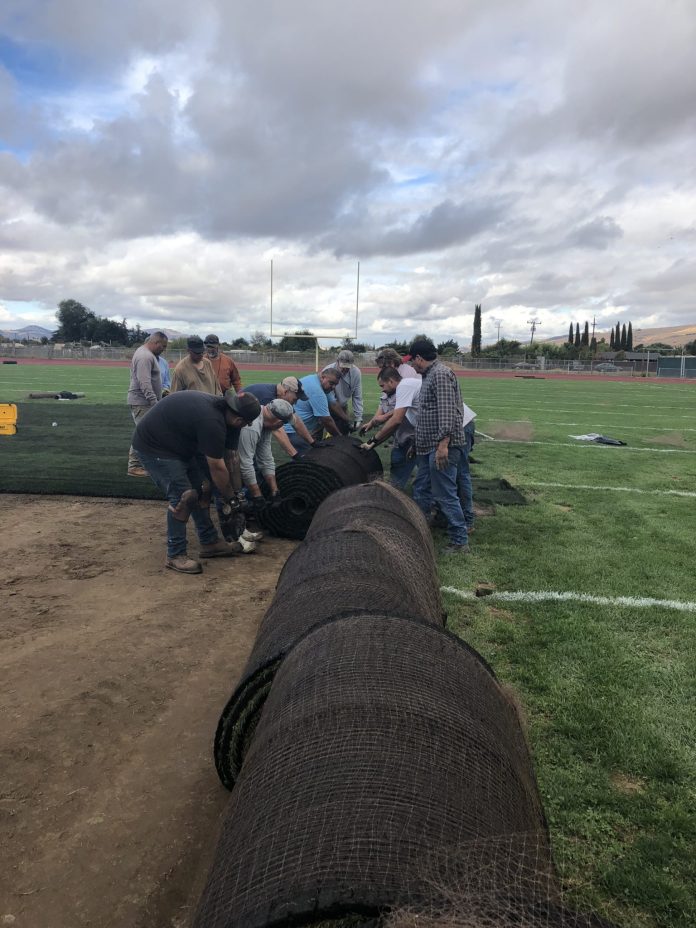
A renewed push to get permanent bleachers and lights at Ann Sobrato High School is facing the same major roadblock that it has for more than a decade: San Jose’s Greenline/Urban Growth Boundary.
Morgan Hill Unified School District Superintendent Steve Betando recently met with San Jose officials to discuss the issue, days after vandals drove a vehicle onto the Sobrato football field off Burnett Avenue and spun doughnuts. The field was so torn up that games were moved to Live Oak High School for one weekend. An access gate was left open after the temporary bleachers were taken down and transported offsite as they are each weekend after home games.
Betando hoped to turn the unfortunate and costly event—the district paid thousands for new sod to be rolled out in time for the following week’s homecoming games—into a positive action for Sobrato’s student body.
However, no new developments have been reported in the district’s push to bring weekly “Friday Night Lights” football games to the Morgan Hill high school.
Sobrato football coach Tony Holmes said the team is put at a disadvantage by not having regular Friday night home games. In 2016, after being granted approval and renting portable lights, Sobrato had its first evening home game. Ticket and concession sales were at an all-time high in comparison to the Saturday daytime games, according to Holmes.
“We had the largest turnout for a home game ever,” said Holmes, who took over the football program in 2015. “It was a great experience and opportunity for us.”
The next season, Sobrato played four Friday night games, renting lights and bleachers each time.
“The district is spending large amounts of money on these rentals,” said Holmes, adding that the cost to rent lights jumped from $1,880 to $2,550 per game the second year. “It’s costly for the program. It’s costly for the school. It requires a lot of man hours. We have to set up and break down the lights.”
Local open space advocates, however, believe that inconvenience pales in comparison to preserving the rural land meant for agriculture and wildlife—and no manmade development of any kind—within San Jose’s protected greenbelt.
“What it really comes down to is the greenbelt is intended to maintain the rural (landscape) for agriculture or open space,” said Alice Kaufman, a legislative advocacy director with the Committee for Green Foothills. “To make an exception for this would just open the gates to, ‘What about housing? We have a housing crisis. What about this and that?’”
Kaufman said she has met with Betando several times to discuss the district’s desire to build a permanent sports field on the north Morgan Hill campus and see if something could be done to make it happen. But she said the district “would have to overcome a lot of barriers to do what they want.”
MHUSD district staff has had more than a dozen meetings or conference calls since August 2015 with various entities, including members of Green Foothills, the county’s Open Space Authority, the City of San Jose and also City Councilman Sergio Jimenez, to state their case for upgrading the Sobrato football field. They hoped the latest incident of vandalism would help their cause.
But Brian Schmidt, a program director with the Greenbelt Alliance, said the only way the restrictions could be lifted is by another vote by San Jose residents or major revisions to the city’s general plan.
“Before this high school was built, they made certain environmental promises,” Schmidt said. “Now that those promises are not convenient, they want to change them.”
In that agreement, made on Aug. 31, 2001, three years prior to Sobrato’s opening, the school district agreed to “make arrangements to effectuate the open space portion of the high school project and to preserve, to the greatest extent possible, the integrity of the Sobrato site as open space which will thereafter be utilized consistently with San Jose and Morgan HIll greenbelt policies.” The agreement also set guidelines for building expansion to accommodate increased enrollment at the school.
Sobrato, which opened in September 2004, was built on the border of Morgan Hill and San Jose in the area known as the Greenline, or Greenbelt, where development is restricted. The campus, which sits on the Morgan Hill side of the border, is outside the restricted area but the athletic fields fall within it, inside the city limits of San Jose.
In 2000, 81.4 percent of San Jose voters approved Measure K, which enacted policies of the San Jose 2020 General Plan that “protect the city’s greenbelt, hillsides and baylands from urban development,” it states. The measure also “affirmed with a requirement that (those policies) may only be repealed or amended by the voters of the City of San Jose.”
Those rules prevent any permanent structures from being built inside the greenbelt beyond those that are already there. So when the school opened, it included a football field with no bleachers, no light standards, no concession stands and no restrooms.
In 2014, Sobrato played its home games at Live Oak High School. In 2015, it started playing Saturday afternoon games at Sobrato. The following year, Sobrato hosted its first evening football game, and they would like to do that on a regular basis.
“It has a very big impact on our kids, playing in front of friends, family and the student body” on Friday night Holmes said. “Traditionally, playing under the lights on Friday night is what everyone wants. … The biggest difference is the support we get.”
Holmes said Sobrato already has the support from the City of Morgan Hill and the MHUSD district office, but “we’re just waiting on confirmation from the City of San Jose.”







